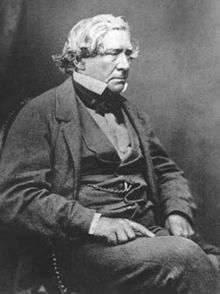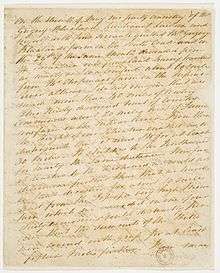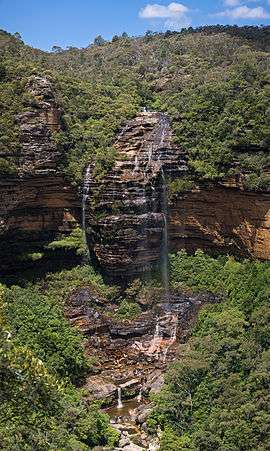William Wentworth
William Charles Wentworth (13 August 1790 – 20 March 1872)[1] was an Australian explorer, journalist, politician and author, and one of the leading figures of early colonial New South Wales. He was the first native-born Australian to achieve a reputation overseas, and a leading advocate for self-government for the Australian colonies.
William Wentworth | |
|---|---|
 c. 1861 | |
| Born | William Charles Wentworth 13 August 1790 Norfolk Island |
| Died | 20 March 1872 (aged 81) England |
| Burial place | Wentworth Mausoleum, Vaucluse |
| Nationality | Australian |
| Education | Peterhouse, Cambridge, Middle Temple, London |
| Occupation | Pastoralist |
| Years active | 1820s – 1860s |
| Known for | Explorer, author, newspaper owner and politician |
| Spouse(s) | Sarah Cox |
| Children | 11 children |
Birth
William Charles Wentworth was born on 13 August 1790 to D'Arcy Wentworth and Catherine Crowley. D'Arcy was the impecunious distant offspring of the aristocratic Wentworth family. D'Arcy was born in Ireland in 1762, but had left to train as a surgeon in London. To maintain his lifestyle he apparently became a highwayman, but soon found himself in trouble with the law. After being acquitted four times of highway robbery, to avoid a further prosecution, D'Arcy took the position of assistant surgeon to the new colony of New South Wales. He boarded the Neptune sometime in December 1789. On board the ship was a seventeen-year-old girl from Ireland, who was being transported to Sydney following a conviction for stealing some clothing.[1] On board ship, D'Arcy Wentworth and Catherine Crowley became lovers.
The Neptune arrived in Sydney as part of the Second Fleet on 29 June 1790.[2][3]:6 D'Arcy and Catherine, now heavily pregnant, departed for Norfolk Island on the Surprize. While anchored off Norfolk Island in August, possibly the 13th, Catherine gave birth to a son whom she named William. Although born less than nine months after they first met, D'Arcy acknowledged the boy as his.[3]:8
There has always been confusion about the date and circumstances of Wentworth's birth. The text of his obituary in the Sydney Morning Herald of 6 May 1872,[4][5] says about the year 1792. Burke's Colonial Gentry, 1891–1896, Page 96, says he was born in 1793, describes his mother as Catherine Parry, and that she was the wife of D'Arcy. In the biography "William Charles Wentworth" by A C V Melbourne, he says that he was born in 1792.[6] His mother is believed to have been a Catherine Williams, who had been a convict on the Neptune, where D'arcy first became acquainted with her.[7] The date 26 October 1793 was celebrated as his birth date for some years.[8] His coffin had attached to it a plate of pure silver which bore the simple inscription, William Charles Wentworth, born 26 October 1793 died March, 20th, 1872.[9]
Early life
In 1796 D'Arcy and Catherine Wentworth moved from Norfolk Island to Sydney, with the young William. The family lived at Parramatta, where his father became a prosperous landowner. Catherine died at Parramatta in 1800.[1] In 1803 William along with his brother, was sent to England, where he was educated at a school in Greenwich.[10] In about 1807, D'Arcy Wentworth sold 450 acres (180 ha) at the Brush Farm (near Eastwood) to Gregory Blaxland for £1,500. William returned to Sydney in 1810, where he was appointed acting Provost Marshal by Governor Lachlan Macquarie, and given a land grant of 1,750 acres (710 ha)[1] on the Nepean River.
On 15 October 1810, at Hyde Park, now in the centre of Sydney, Wentworth rode his father's horse Gig to victory in the first official horse races on Australian soil.[11]
Crossing the Blue Mountains

In 1813 Wentworth, along with Gregory Blaxland and William Lawson, led the expedition which found a route across the Blue Mountains west of Sydney and opened up the grazing lands of inland New South Wales. Wentworth kept a journal of the exploration which begins by describing the first day of the journey:
On the Eleventh of May our party consisting of Mr. Gregory Blaxland, Lieutenant Lawson and Myself with four servants quitted Mr. Gregory Blaxland's farm on the South Creek and on the 29th of the June Month descended from the Mountain into forest land having travelled as nearly as I can compute about 60 Miles from Mr. Chapman's farm on the Nepean River although I do not imagine that we made more than 40 Miles of Westing.[12]
In the journal, Wentworth describes the landscapes they were exploring:
A country of so singular a description could in my opinion only have been produced by some Mighty convulsion in Nature – Those immense unconnected perpendicular Masses of Mountain which are to be seen towards its Eastern Extremity towering above the Country around, seem to indicate that the whole of this tract has been formed out of the Materials of the primitive mountains of which these masses are the only parts that have withstood the violence of the concussion.'[12]
The town of Wentworth Falls in the Blue Mountains commemorates his role in the expedition. As a reward he was granted another 1,000 acres (4.0 km2).[1] He then combined farming with sandalwood trading in the South Pacific, where the captain of the ship died at Rarotonga and Wentworth safely brought the ship back to Sydney.[1]
Studying in England
Wentworth returned to England in 1816. There he was admitted to the bar, travelled in Europe, and studied at Cambridge University, initially matriculating in Magdalene College.[10]
In 1819 Wentworth published the first book written by an Australian: A Statistical, Historical, and Political Description of the Colony of New South Wales and Its Dependent Settlements in Van Diemen's Land, With a Particular Enumeration of the Advantages Which These Colonies Offer for Emigration and Their Superiority in Many Respects Over Those Possessed by the United States of America,[1] in which he advocated an elected assembly for New South Wales, trial by jury and settlement of Australia by free emigrants rather than convicts.
Wentworth successfully completed his legal studies by 1822 and was called to the bar. In 1823 he was admitted to Peterhouse, Cambridge.[13] That year he also published an epic poem Australasia, which contains lines now famous in Australia:[14]
- And, O Britannia!... may this — thy last-born infant — then arise,
- To glad thy heart, and greet thy parent eyes;
- And Australasia float, with flag unfurl'd,
- A new Britannia in another world!
Political life
.tif.jpg)
Wentworth returned to Sydney in 1824, accompanied by Robert Wardell.[15] D'Arcy Wentworth died in 1827 and William inherited his property, becoming one of the wealthiest men in the colony. He bought land in eastern Sydney and built a mansion, Vaucluse House, from which the modern suburb takes its name.
However, because his parents had never married, and his mother had been a convict, and his wife was the daughter of two convicts, Francis Cox and Frances Morton, he could not become a member of Sydney's "respectable" class, known as "the exclusives". Embittered by this rejection, he placed himself at the head of the "emancipist" party, which sought equal rights and status for ex-convicts and their descendants.[10]
A wild but gifted orator and a vitriolic journalist, Wentworth became the colony's leading political figure of the 1820s and '30s, calling for representative government, the abolition of transportation, freedom of the press and trial by jury. He became a bitter enemy of Governor Ralph Darling and the exclusives, led by the wealthy grazier John Macarthur and his friends. Macarthur's opposition to Wentworth was personal as well as political. Macarthur had broken up the relationship between his daughter Elizabeth and Wentworth, as he would not allow his daughter to marry someone with convict parents.[1]
Wentworth became Vice-President of the Australian Patriotic Association and founded a newspaper, The Australian, the colony's first privately owned paper, to champion his causes (this paper has no connection with the current Australian). With a liberal editorial leaning, the paper was in frequent conflict with Governor Darling,[16] who was recalled in 1831.[10]
Under successive governors of differing opinions, Wentworth continued to exercise a powerful influence.[10] By 1840 the political climate in New South Wales had changed. With the abolition of transportation and the establishment of an elected Legislative Council, the dominant issue became the campaign to break the grip of the squatter (pastoral) class over the colony's lands, and on this issue Wentworth sided with his fellow landowners against the democratic party, who wanted to break up the squatters' runs for small farmers. He was elected to the Council in 1843 for City of Sydney and soon became the leader of the conservative party, opposed to the liberals led by Charles Cowper.[17] In 1852 he founded the University of Sydney, where his son afterwards founded bursaries in his honour.[10]
In 1853 Wentworth chaired the committee to draft a new constitution for New South Wales, which was to receive full responsible self-government from Britain. His draft provided for a powerful unelected Legislative Council and an elected Legislative Assembly with high property qualifications for voting and membership. He also suggested the establishment of a colonial peerage drawn from the landowning class. This draft aroused the bitter opposition of the democrats and radicals such as Daniel Deniehy, who ridiculed Wentworth's plans for what he called a "bunyip aristocracy".
The draft constitution was substantially changed to make it more democratic, although the Legislative Council remained unelected. With the establishment of responsible government in 1856 Wentworth retired from the Council and settled in England, where he founded the "General Association for the Australian Colonies", whose object was to obtain a federal assembly for the whole of Australia.[10] He refused several offers of honours, and was a member of the Conservative Party in the 1860s. He died in England, but at his request his body was returned to Sydney for burial. He was given the colony's first state funeral on 6 May 1873, a day declared by the governor as a public holiday.[18]
His family has remained prominent in Sydney society, and his great-grandson Bill Wentworth was a Liberal member of Parliament 1949–77.
Business
Wentworth was a director of the Bank of New South Wales (1825–1852).[19] He was a co-founder of The Australian newspaper in 1824. He provided £4,000 in capital and running costs to support the newspaper and wrote the occasional editorial.[20]
Family
In 1829 William Wentworth married Sarah Cox (1805–1880), with whom he had seven daughters and three sons:
- Thomasine Wentworth (1825–1913)
- William Charles Wentworth (1827–1859) died without issue
- Fanny Katherine Wentworth (1829–1893)
- Fitzwilliam Wentworth (1833–1915) married Mary Jane Hill
- William Charles Wentworth III (1871–1949) married Florence Denise Griffiths, daughter of George Neville Griffiths
- William Charles Wentworth IV (1907–2003)
- Diana Wentworth Wentworth married Mungo Ballardie MacCallum (1913–99)
- Mungo Wentworth MacCallum (1941– )
- William Charles Wentworth III (1871–1949) married Florence Denise Griffiths, daughter of George Neville Griffiths
- Sarah Eleanor Wentworth (1835–1857)
- Eliza Sophia Wentworth (1838–1898)
- Isabella Christiana (Christina) Wentworth (1840–1856)
- Laura Wentworth (1842–1887) married Henry William Keays-Young in 1872.
- Edith Wentworth (1845–1891) married Rev. Sir Charles Gordon-Cumming-Dunbar, 9th Baronet in 1872.
- D'Arcy Bland Wentworth (1848–1922), died without heirs. His estate went to W. C. Wentworth III
He fathered at least one other child out of wedlock with Jamima Eagar, the estranged wife of Edward Eagar
Recognition

The towns of Wentworth and Wentworth Falls, the federal Division of Wentworth, an electorate in Sydney's Eastern Suburbs, the Wentworth Falls waterfall, and Wentworth Avenue which runs through the suburb of Kingston in Canberra, were named after him.
An eight-foot high statue of Wentworth, sculpted by Pietro Tenerani of Rome, stands at the University of Sydney. Another statue of Wentworth is located on the exterior of the Department of Lands building in Sydney.
In 1963 he was honoured, together with Blaxland and Lawson, on a postage stamp issued by Australia Post depicting the Blue Mountains crossing,[21] and again in 1974 on the anniversary of the first newspaper publication.[22]
The Wentworth Building, where University of Sydney Union resides, was named after William Wentworth.
Pastoralist and newspaperman Horatio Wills named his son Thomas Wentworth Wills in homage of Wentworth, who was a close friend of Horatio's and served as the Wills family's lawyer. Thomas went on to become a renowned cricketer and co-founder of Australian rules football.
His clash with Darling was dramatised in the series The Patriots (1962).
Works
Sources
- Barton, The Poets and Prose Writers of New South Wales (Sydney, 1866)
- Rusden, History of Australia (London, 1883)
- Lewis Deer and John Barr: Australia's First Patriot: The Story of William C. Wentworth: Angus & Robertson Ltd.: Sydney 1911.
- K. R. Cramp, M. A.: William Charles Wentworth of Vaucluse House: A.H. Pettifer Government Printer: Third Edition 1923
- Carol Liston (1988). Sarah Wentworth, Mistress of Vaucluse: Historic Houses Trust of NSW ISBN 0-949753-34-3.
- John Ritchie[25] (1997). The Wentworths: Father and Son. The Miegunyah Press at Melbourne University Press. ISBN 0-522-84751-X.
- Ivy Bailey (1999). Single-handed Patriot: A Story of William Charles Wentworth: Book House: Glebe, NSW. ISBN 9781740180306.
- Andrew Tink (2009), William Charles Wentworth: Australia's greatest native son Allen & Unwin. ISBN 978-1-74175-192-5
- Robert Griffin, Joy Hughes, Anne Toy and Peter Watts: Vaucluse House: A History and Guide: Historic Houses Trust of New South Wales: 3rd Edition 2006.
See also
- Political families of Australia: Wentworth/Hill/Griffiths/Scott/Cooper family
- Wentworth family
References
- Persse, Michael. "Wentworth, William Charles (1790–1872)". Australian Dictionary of Biography. Melbourne University Press. ISSN 1833-7538. Retrieved 18 April 2019 – via National Centre of Biography, Australian National University.
- Ritchie, John; Brissenden collection (1997), The Wentworths : father and son, Miegunyah Press, p. 40, ISBN 978-0-522-84751-2
- Tink, Andrew (2009). William Charles Wentworth : Australia's greatest native son. Allen & Unwin. ISBN 978-1-74175-192-5.
- "Obituary - William Charles Wentworth". Obituaries Australia. National Centre of Biography.
- "William Charles Wentworth". The Sydney Morning Herald. 6 May 1872. p. 5 – via National Library of Australia.
- Melbourne, A C V (1934). William Charles Wentworth. Brisbane: Biggs. OCLC 5734962.
- "LITERATURE". The Advertiser. Adelaide. 22 September 1934. p. 8 – via National Library of Australia.
- "Wentworth's birthday". The Sydney Morning Herald. 27 October 1923. p. 18 – via National Library of Australia.
"To-days yesterdays". The Courier-Mail. Brisbane. 26 October 1933. p. 12 – via National Library of Australia.
"Anniversaries". The West Australian. Perth. 26 October 1935. p. 18 – via National Library of Australia.
"Wentworth memorial service". The Sydney Morning Herald. 23 November 1937. p. 7 – via National Library of Australia.
"W C Wentworth". The Sydney Morning Herald. 24 October 1936. p. 13 – via National Library of Australia.
"Australian almanac". The Australian Women's Weekly. 25 October 1967. p. 35 – via National Library of Australia. - "Public funeral of Mr W C Wentworth". The Empire. Sydney. 7 May 1873. p. 2 – via National Library of Australia.
- Chisholm, Hugh, ed. (1911). . Encyclopædia Britannica. 28 (11th ed.). Cambridge University Press.CS1 maint: ref=harv (link)
- Sydney Sydney Gazette & NSW Advertiser
- "Wentworth's journal". Discover Collections. State Library of New South Wales. Retrieved 15 April 2013.
- "Wentworth, William Charles (WNTT823WC)". A Cambridge Alumni Database. University of Cambridge.
- Frank Welsh, Great Southern Land: A New History of Australia, Penguin Books, 2005, p.27 (ISBN 0-140-29132-6)
- Serle, Percival (1949). "Wentworth, William Charles". Dictionary of Australian Biography. Sydney: Angus and Robertson. Retrieved 20 April 2019.
- Victor Isaacs and Rod Kirkpatrick. "Two hundred years of Sydney newspapers: a short history" (PDF). Rural Press Ltd. Retrieved 16 April 2013.
- "Mr William Charles Wentworth (1790 - 1872)". Former Members of the Parliament of New South Wales. Retrieved 9 April 2019.
- The Dictionary of Sydney. Retrieved 3 November 2017
- 200 The Westpac Story: 200 years supporting Australia published 2017 by Westpac Banking Corporation 2017 p.296 ISBN 9780646964102
- Ritchie, p.209.
- 1963 postage stamp
- 1974 Postage stamp
- A Statistical Account of the British Settlements in Australasia (1819) Retrieved 18 July 2020
- Journal of an expedition, across the Blue Mountains, 11 May-6 June 1813, 1813
- John Ritchie: Obituary. Retrieved 12 December 2012
External links
| Wikisource has original text related to this article: |
- Portrait of William Charles Wentworth (bronze medallion) in the National Portrait Gallery, London
- Portrait of William Charles Wentworth (copy print) digitised and held by the State Library of Queensland
- The Wentworth family
- New South Wales State Library: Catalogue: Crossing the Blue Mountains
- Lisa Murray (2013). "First State funeral [in colonial New South Wales]". Dictionary of Sydney. Dictionary of Sydney Trust. Retrieved 10 October 2015.
- Works by William Wentworth at Project Gutenberg
- Works by or about William Wentworth at Internet Archive
- Works by William Wentworth at LibriVox (public domain audiobooks)

| New South Wales Legislative Council | ||
|---|---|---|
| New creation | Member for City of Sydney June 1843 – April 1854 With: William Bland 1843–48, 1849–50 Robert Lowe 1848–49 John Dunmore Lang 1850–51 Robert Campbell 1851–54 John Lamb 1851–53 William Thurlow 1853–54 |
Succeeded by Henry Parkes |
| Preceded by William Westbrooke Burton |
President of the New South Wales Legislative Council 24 June 1861 – 10 October 1862 |
Succeeded by Terence Aubrey Murray |